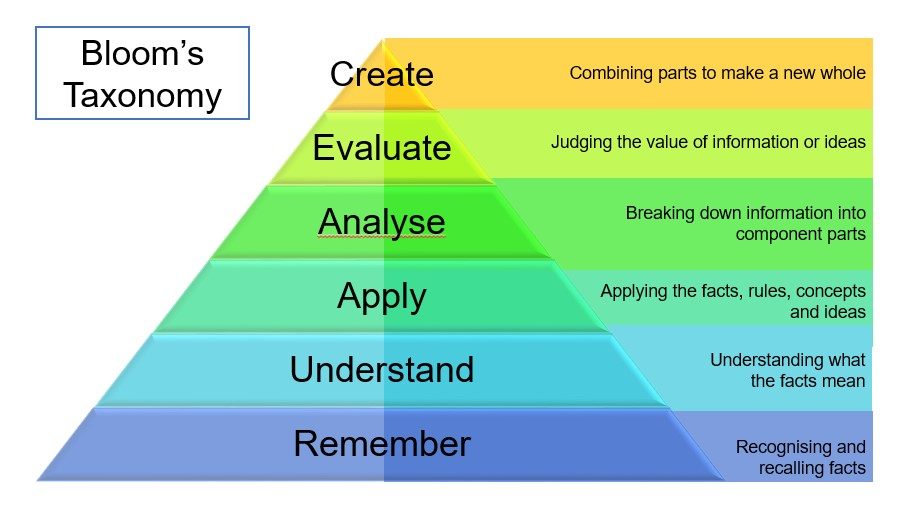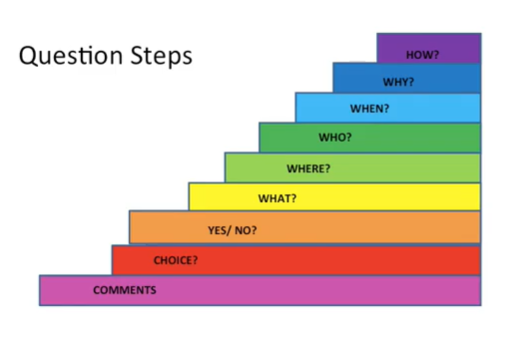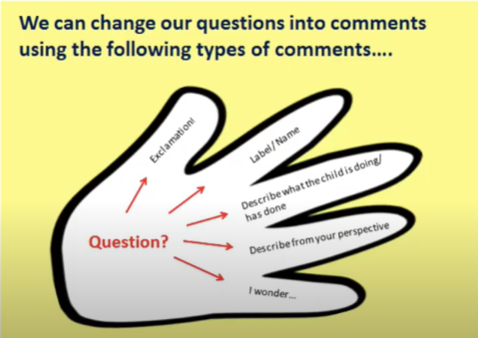Questioning
“We use skilled questioning and interact in a sensitive, responsive and stimulating way to promote curiosity, independence and confidence. We listen effectively to children and they know their views are respected and acted upon…”
(How Good Is Our Early Learning and Childcare, Education Scotland, 2016, p. 29)
Questions are often used to assess a child’s knowledge or initiate an interaction. Use questioning carefully; practitioners need to use their knowledge of the child, their age and developmental stage to inform whether these are closed questions or open/possibility questions that demand more complex and higher-order thinking (Blooms Taxonomy, 2021).

A child’s ability to understand and respond to questions is linked to their developmental stage. In recognising how comprehension of different questions develops, we can ensure that we pitch the developmentally correct level of question to a child. The diagram below demonstrates how a child’s understanding of questions develops from simple comments, choice and yes/no questions to the more challenging what, where, who, or when questions. A child in Primary 1 may still find why or how questions challenging.

Allow children thinking time; time to reflect on the question asked.
Practitioners can scaffold thinking skills for those who need support to answer.
Plan for questions and interactions where appropriate to support the intentional planning, which will help extend thinking while encouraging problem-solving, deeper thinking and creativity (Sustained Shared Thinking).
Our learning environment needs to be skilfully planned to enable children to develop their vocabulary and questioning skills through curious, imaginative, experimental, and creative opportunities. The children should have many opportunities to ask questions as part of their learning indoors and outdoors.
Asking a question can make adults and children feel under pressure, so be sure to tune into a child. If they do not answer a question, avoid asking a second one. Instead, transform a question into a comment.
(‘Words Up’ Early Level 1 training, Highland Literacy, 2018)
For example, if the original question was “How are you making those bubbles?” we could use the following alternative comments:
- Exclamation: “Wow, what beautiful bubbles!”
- Label or name: “That is a small one, but that is a bigger one!”
- Describe what the child is doing: “I see – you dip the wand into the soapy water and blow slowly,”
- Describe from your own perspective: “I love watching them float… and then popping them with my finger, POP!”
- Pondering: “I wonder how we could make an even larger bubble?”
If we consider Open, Closed and Possibility questions:
- Closed questions have a single word answer, where the adult often has a particular answer that a child has to find. Examples: “What colour is the sky?”, “How was your day?”, “What’s your favourite food?”, “Do you have a sister/brother?”
- Open questions are considered beneficial in helping a child’s thinking. This is because they have a range of answers to choose from, encourage higher levels of engagement, and stimulate curiosity, creativity, and critical thinking, e.g.“I wonder what…?”, “What do you think would happen if…?”, “How does it work?”
However, an open question can sometimes be too big or complex for a young child, a child with English as an additional language or delayed language development. In these situations, a simple closed question is actually more appropriate.
- Adult: What did you have for snack today?
- Child: ……..
- A: Did you have crackers?
- Ch: No
- A: Did you have….. Cheese?
- Ch: No
- A: Did you have…… Toast?
- Ch: Yes!
- A: Oh lovely! I wonder what you had on it….?
Again, that is about knowing the children in your care. There may be times it is developmentally appropriate to give a child a choice (as indicated in the ‘Words Up’ video above) to choose from to support them in learning to make decisions and answer questions, e.g. “Would you like toast or an apple for a snack?”.
Closed questions can sometimes be a way to lead to an open question; however, not all children are developmentally ready for an open or a possibility question.
Possibility questions are to encourage more creative, open responses from the children; to make them think about what might be, e.g. “What was the most difficult part of building your space station?”, “How could you make it even better?”
Again, these questions require you to know your children well and whether it is developmentally appropriate to ask these questions. Knowing your children, being aware of these different questions and their uses as part of Shared Sustained Thinking.
Sometimes questioning is not appropriate. See Keys to Communication for other ways to engage with children to support speech and language development.

